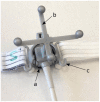Case Report: Treatment Planning Study to Demonstrate Feasibility of Transthoracic Ultrasound Guidance to Facilitate Ventricular Tachycardia Ablation With Protons
- PMID: 35600462
- PMCID: PMC9116532
- DOI: 10.3389/fcvm.2022.849247
Case Report: Treatment Planning Study to Demonstrate Feasibility of Transthoracic Ultrasound Guidance to Facilitate Ventricular Tachycardia Ablation With Protons
Abstract
Background: Cardiac arrhythmias, such as ventricular tachycardia, are disruptions in the normal cardiac function that originate from problems in the electrical conduction of signals inside the heart. Recently, a non-invasive treatment option based on external photon or proton beam irradiation has been used to ablate the arrhythmogenic structures. Especially in proton therapy, based on its steep dose gradient, it is crucial to monitor the motion of the heart in order to ensure that the radiation dose is delivered to the correct location. Transthoracic ultrasound imaging has the potential to provide guidance during this treatment delivery. However, it has to be noted that the presence of an ultrasound probe on the chest of the patient introduces constraints on usable beam angles for both protons and photon treatments. This case report investigates the possibility to generate a clinically acceptable proton treatment plan while the ultrasound probe is present on the chest of the patient.
Case: A treatment plan study was performed based on a 4D cardiac-gated computed tomography scan of a 55 year-old male patient suffering from refractory ventricular tachycardia who underwent cardiac radioablation. A proton therapy treatment plan was generated for the actual treatment target in presence of an ultrasound probe on the chest of this patient. The clinical acceptability of the generated plan was confirmed by evaluating standard target dose-volume metrics, dose to organs-at-risk and target dose conformity and homogeneity.
Conclusion: The generation of a clinically acceptable proton therapy treatment plan for cardiac radioablation of ventricular tachycardia could be performed in the presence of an ultrasound probe on the chest of the patient. These results establish a basis and justification for continued research and product development for ultrasound-guided cardiac radioablation.
Keywords: cardiac motion monitoring; protons; stereotactic radioablation; ultrasound; ventricular tachycardia.
Copyright © 2022 Perrin, Maguire, Garonna, Weidlich, Bulling, Fargier-Voiron, De Marco, Rossi, Ciocca, Vitolo and Mirandola.
Conflict of interest statement
PM is founder and owner of MedDevicePharma LLC. GW is founder and owner of National Medical Physics and Dosimetry Company. PM and GW are consultants to EBAMed SA. RP was previously employed and AG is still employed by EBAMed SA. The remaining authors declare that the research was conducted in the absence of any commercial or financial relationships that could be construed as a potential conflict of interest.
Figures


Similar articles
-
Dosimetric feasibility study ("proof of concept") of refractory ventricular tachycardia radioablation using proton minibeams.Cancer Radiother. 2024 Apr;28(2):195-201. doi: 10.1016/j.canrad.2024.02.002. Epub 2024 Apr 9. Cancer Radiother. 2024. PMID: 38599941
-
Case report: First-in-human combined low-dose whole-heart irradiation and high-dose stereotactic arrhythmia radioablation for immunosuppressive refractory cardiac sarcoidosis and ventricular tachycardia.Front Cardiovasc Med. 2023 Jul 21;10:1213165. doi: 10.3389/fcvm.2023.1213165. eCollection 2023. Front Cardiovasc Med. 2023. PMID: 37547255 Free PMC article.
-
Reinforcing treatment and evaluation workflow of stereotactic ablative body radiotherapy for refractory ventricular tachycardia.Radiat Oncol J. 2024 Dec;42(4):319-329. doi: 10.3857/roj.2024.00262. Epub 2024 Dec 24. Radiat Oncol J. 2024. PMID: 39748532 Free PMC article.
-
Stereotactic radioablation for ventricular tachycardia.Herzschrittmacherther Elektrophysiol. 2022 Mar;33(1):49-54. doi: 10.1007/s00399-021-00830-y. Epub 2021 Nov 26. Herzschrittmacherther Elektrophysiol. 2022. PMID: 34825951 Review. English.
-
Ablative Radiotherapy as a Noninvasive Alternative to Catheter Ablation for Cardiac Arrhythmias.Curr Cardiol Rep. 2017 Sep;19(9):79. doi: 10.1007/s11886-017-0886-2. Curr Cardiol Rep. 2017. PMID: 28752279 Free PMC article. Review.
Cited by
-
Deep learning-based ultrasound transducer induced CT metal artifact reduction using generative adversarial networks for ultrasound-guided cardiac radioablation.Phys Eng Sci Med. 2023 Dec;46(4):1399-1410. doi: 10.1007/s13246-023-01307-7. Epub 2023 Aug 7. Phys Eng Sci Med. 2023. PMID: 37548887 Free PMC article.
-
Analysis of left ventricle regional myocardial motion for cardiac radioablation: Left ventricular motion analysis.J Appl Clin Med Phys. 2024 May;25(5):e14333. doi: 10.1002/acm2.14333. Epub 2024 Mar 17. J Appl Clin Med Phys. 2024. PMID: 38493500 Free PMC article.
-
Cardiorespiratory-gated cardiac proton radiotherapy using a novel ultrasound guidance system.Clin Transl Radiat Oncol. 2024 Dec 21;51:100904. doi: 10.1016/j.ctro.2024.100904. eCollection 2025 Mar. Clin Transl Radiat Oncol. 2024. PMID: 39867728 Free PMC article.
-
Combined clustered scan-based metal artifact reduction algorithm (CCS-MAR) for ultrasound-guided cardiac radioablation.Phys Eng Sci Med. 2022 Dec;45(4):1273-1287. doi: 10.1007/s13246-022-01192-6. Epub 2022 Nov 9. Phys Eng Sci Med. 2022. PMID: 36352318 Free PMC article.
-
Radiation therapy for ventricular arrhythmias.J Med Imaging Radiat Oncol. 2024 Dec;68(8):893-913. doi: 10.1111/1754-9485.13662. Epub 2024 May 2. J Med Imaging Radiat Oncol. 2024. PMID: 38698577 Free PMC article. Review.
References
Publication types
LinkOut - more resources
Full Text Sources

